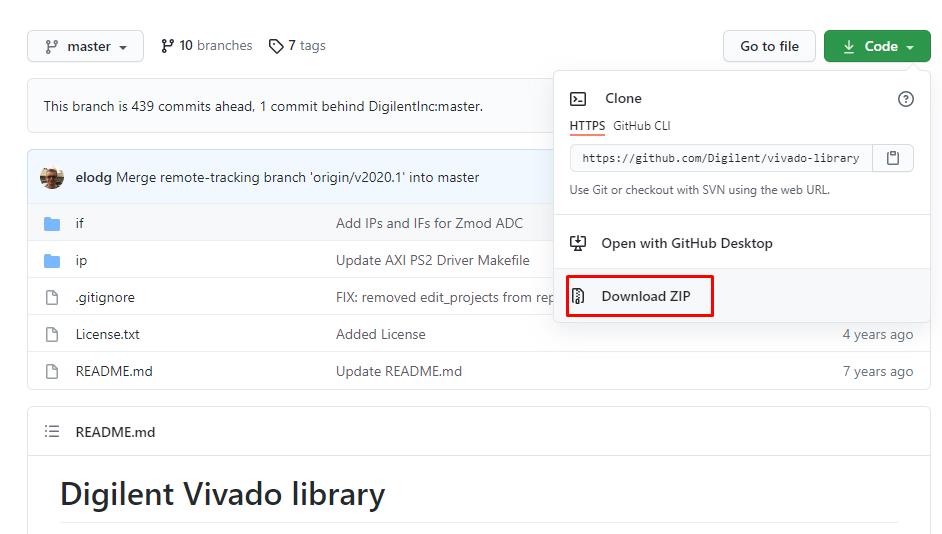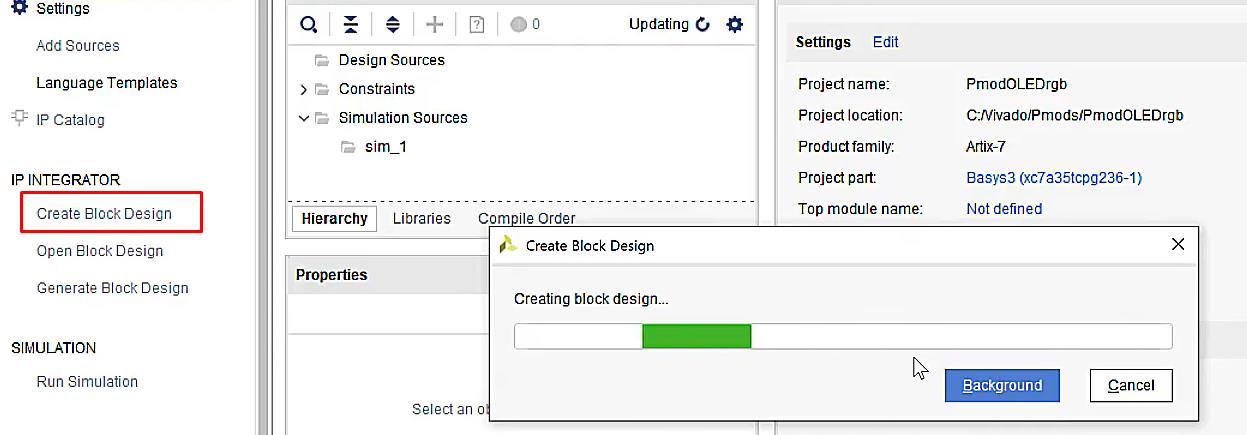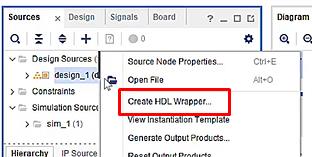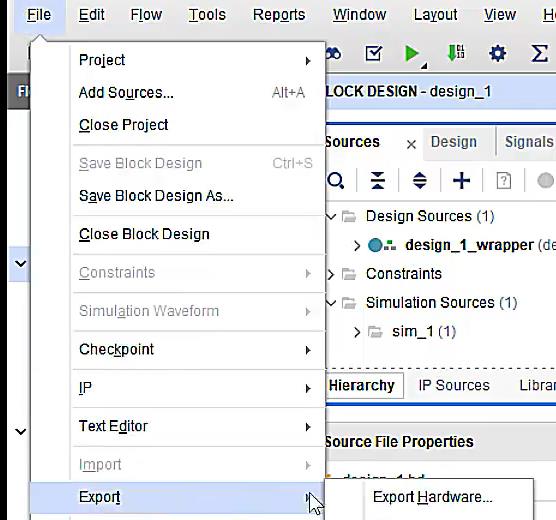basys3利用microblaze连接Pmod OLEDrgb
Posted 只是有点小怂
tags:
篇首语:本文由小常识网(cha138.com)小编为大家整理,主要介绍了basys3利用microblaze连接Pmod OLEDrgb相关的知识,希望对你有一定的参考价值。
-
首先要导入basys3的板卡文件,这样方便连接Pmod vivado2018.3根据板卡Boards直接创建工程(比如basys3和Arty A7)
-
首先导入Pmod IP核,这可以在gayhub下载zip文件 https://github.com/Digilent/vivado-library,解压后把整个master文件添加至工程 vivado2018.3添加IP库

-
注意是这整个project

-
然后创建block design

-
点击Board,把System Clock拖到Diagram创建系统时钟

-
添加microblaze并点击run block automation把Local Memory修改为128KB

-
双击Connector JB,选择需要连接的接口PmodOLEDrgb

-
顺便把uart拖进来

-
配置时钟IP双击,打勾clk_out2并修改为50然后点击OK

-
将PmodOLEDrgb的est_spi_clk连接到50MHz的输出端口

-
因为PmodOLEDrgb是需要配置外部的50M时钟的,可以在一下链接查看 https://reference.digilentinc.com/learn/programmable-logic/tutorials/pmod-ips/2018.2

-
点击run connection automation自动布线

-
在sources窗口下点击生成顶层文件

-
生成比特流,碰见警告直接OK,导入硬件并打开SDK

-
SDK下新建一个空白文件,把驱动示例复制进src

-
还有examples的函数也复制进去,打开main.c就是运行的程序

-
把pmod插入JB口,progam fpga并run,最后可以看见pmodrgb亮起

-
以上步骤和zynq开发很类似,有些地方省略写了,只为记录过程,具体可以参考视频
-
main函数代码,有空可以研究一下
/******************************************************************************/
/* */
/* main.c -- Demo project for the PmodOLEDrgb IP */
/* */
/******************************************************************************/
/* Author: Thomas Kappenman */
/* Copyright 2016, Digilent Inc. */
/******************************************************************************/
/* File Description: */
/* */
/* This demo project initializes and uses the PmodOLEDrgb to display strings */
/* of different colors and a BMP image. */
/* */
/******************************************************************************/
/* Revision History: */
/* */
/* 02/08/2016(TommyK): Created */
/* 08/25/2017(artvvb): Added proper cache management functions */
/* 11/11/2017(atangzwj): Validated for Vivado 2016.4 */
/* 02/17/2018(atangzwj): Validated for Vivado 2017.4 */
/* */
/******************************************************************************/
#include "bitmap.h"
#include "PmodOLEDrgb.h"
#include "sleep.h"
#include "xil_cache.h"
#include "xparameters.h"
void DemoInitialize();
void DemoRun();
void DemoCleanup();
void EnableCaches();
void DisableCaches();
PmodOLEDrgb oledrgb;
u8 rgbUserFont[] =
0x00, 0x04, 0x02, 0x1F, 0x02, 0x04, 0x00, 0x00, // 0x00
0x0E, 0x1F, 0x15, 0x1F, 0x17, 0x10, 0x1F, 0x0E, // 0x01
0x00, 0x1F, 0x11, 0x00, 0x00, 0x11, 0x1F, 0x00, // 0x02
0x00, 0x0A, 0x15, 0x11, 0x0A, 0x04, 0x00, 0x00, // 0x03
0x07, 0x0C, 0xFA, 0x2F, 0x2F, 0xFA, 0x0C, 0x07 // 0x04
; // This table defines 5 user characters, although only one is used
int main(void)
DemoInitialize();
DemoRun();
DemoCleanup();
return 0;
void DemoInitialize()
EnableCaches();
OLEDrgb_begin(&oledrgb, XPAR_PMODOLEDRGB_0_AXI_LITE_GPIO_BASEADDR,
XPAR_PMODOLEDRGB_0_AXI_LITE_SPI_BASEADDR);
void DemoRun()
char ch;
// Define the user definable characters
for (ch = 0; ch < 5; ch++)
OLEDrgb_DefUserChar(&oledrgb, ch, &rgbUserFont[ch * 8]);
while(1)
OLEDrgb_SetCursor(&oledrgb, 2, 1);
OLEDrgb_PutString(&oledrgb, "Digilent"); // Default color (green)
OLEDrgb_SetCursor(&oledrgb, 4, 4);
OLEDrgb_SetFontColor(&oledrgb, OLEDrgb_BuildRGB(0, 0, 255)); // Blue font
OLEDrgb_PutString(&oledrgb, "OledRGB");
OLEDrgb_SetFontColor(&oledrgb, OLEDrgb_BuildRGB(200, 200, 44));
OLEDrgb_SetCursor(&oledrgb, 1, 6);
OLEDrgb_PutChar(&oledrgb, 4);
OLEDrgb_SetFontColor(&oledrgb, OLEDrgb_BuildRGB(200, 12, 44));
OLEDrgb_SetCursor(&oledrgb, 5, 6);
OLEDrgb_PutString(&oledrgb, "Demo");
OLEDrgb_PutChar(&oledrgb, 0);
// sleep(5); // Wait 5 seconds
//
// OLEDrgb_DrawBitmap(&oledrgb, 0, 0, 95, 63, (u8*) tommy);
void DemoCleanup()
DisableCaches();
void EnableCaches()
#ifdef __MICROBLAZE__
#ifdef XPAR_MICROBLAZE_USE_ICACHE
Xil_ICacheEnable();
#endif
#ifdef XPAR_MICROBLAZE_USE_DCACHE
Xil_DCacheEnable();
#endif
#endif
void DisableCaches()
#ifdef __MICROBLAZE__
#ifdef XPAR_MICROBLAZE_USE_DCACHE
Xil_DCacheDisable();
#endif
#ifdef XPAR_MICROBLAZE_USE_ICACHE
Xil_ICacheDisable();
#endif
#endif
以上是关于basys3利用microblaze连接Pmod OLEDrgb的主要内容,如果未能解决你的问题,请参考以下文章